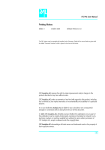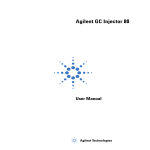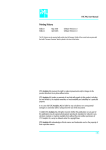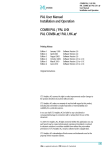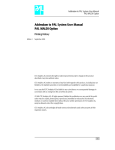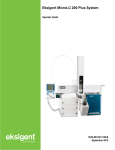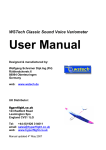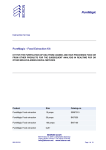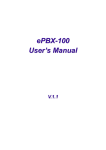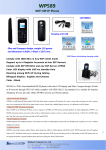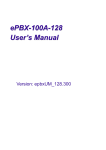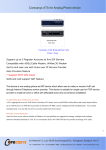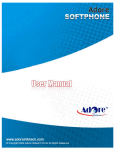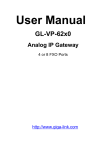Download PAL System Setup Guide
Transcript
ITSP Set-Up Guide Installing ITSP™ on the PAL For HW-KIT – ITSP Hardware Kit 855-395-8300• 706-395-8300 www.ITSPSolutions.com 212 Northlake Drive, Hartwell, GA 30643 ™ Set-Up Guide – Installing ITSP on the PAL Set-Up Guide Installing ITSP™ on the PAL® For ITSP Solutions Product No. HW-KIT – ITSP Hardware Kit 4th Edition, April 2013 The information in this document is subject to change without notice. ITSP Solutions, Inc. makes no warranty of any kind with regard to this material, including, but not limited to, the implied warranties or merchantability and fitness for a particular purpose. ITSP Solutions, Inc. shall not be liable for errors contained herein or for incidental or consequential damages in connection with the furnishing, performance, or use of this material. Contents of this publication may not be reproduced in any form or by any means (including electronic storage and retrieval or translation into a foreign language) without the prior agreement and written consent from the copyright owner. Copyright © 2013 ITSP Solutions, Inc. All rights reserved. ITSP™ is protected under the following US Patents 6,859,615 & 7,001,774. Canadian Patent 2,316,648, and European Block Patent EP 1 174 701. Other US and Foreign Patents Pending. ITSP™ is a trademark of ITSP Solutions, Inc. ITSP Solutions, Inc. Document #: ISDC0001 Rev Date: 130402 Set-Up Guide – Installing ITSP on the PAL Table of Contents Using ITSP™ on the PAL® ................................................................................................. 2 Explanation of the ITSP Cartridge .............................................................................. 3 Explanation of the Hardware Set-Up .......................................................................... 4 Supported Software and Version Requirements ............................................................ 6 Supported Hardware ....................................................................................................... 7 ITSP Hardware Kit Contents ........................................................................................... 8 Example of PAL Hardware Configuration for ITSP ........................................................ 9 Steps to a Successful Installation ................................................................................... 11 Step 1. Assemble the PAL............................................................................................ 11 Step 2. Load the Objects into the PAL ........................................................................ 11 Step 3. Train the Tray Holder Reference Positions ................................................... 12 Step 4. Install the ITSP Hardware Kit PAL Modifications ........................................ 13 Step 5. Train the remaining Object Reference Positions .......................................... 14 Step 6. Backup the PAL configuration....................................................................... 16 Programming the PAL for SPE using ITSP ....................................................................17 Programming the PAL for Sample Filtration using ITSP ............................................. 18 Recommendations for Operating the PAL with ITSP ................................................... 19 Understanding Robust ITSP PAL Operation ................................................................ 21 Design Features ......................................................................................................... 21 Other Factors ............................................................................................................. 22 Troubleshooting............................................................................................................. 24 General Tips and Guidelines ......................................................................................... 25 Appendix............................................................................................................................ 29 Filename Conventions ................................................................................................... 30 Object Definitions in “ITSP Upgrade” PAL Object Lists .............................................. 31 ITSP Tray Types ......................................................................................................... 31 ITSP Tray Holders ..................................................................................................... 32 ITSP Trays .................................................................................................................. 32 ITSP Injectors ............................................................................................................ 32 ITSP Positions ............................................................................................................ 33 Set-Up Guide – Installing ITSP on the PAL Page 2 Table of Figures Figure 1. ITSP Cartridge Cutaway ....................................................................................... 3 Figure 2. ITSP Prep / Waste Station ................................................................................... 7 Figure 3. ITSP Lower Needle Guide .................................................................................... 7 Figure 4. Example of Object Locations on an ITSP PAL .................................................. 10 Figure 5 Example ITSP Setup ........................................................................................... 10 Figure 6. Reference Position for Tray Holders MTHldr1 and MTHldr2 .......................... 12 Figure 7. ITSP Lower Needle Guide .................................................................................. 13 Figure 8. ITSP Waste Receptacle ...................................................................................... 13 Figure 9. Reference Position for ITSPelut ........................................................................ 15 Please Note: ITSP Installation Services Disclaimer If you purchase an ITSP Hardware Kit directly from ITSP Solutions to upgrade an existing PAL or MPS, and decide that you would like assistance from your instrument vendor for hardware installation or software programming, please be aware that they may charge for that service. ITSP Solutions, Inc. Document #: ISDC0001 Rev Date: 130402 Set-Up Guide – Installing ITSP on the PAL Page 3 Using ITSP™ on the PAL® Instrument Top Sample Prep (ITSP™), from ITSP Solutions, Inc., is a consumable cartridge designed to automate filtration and solid phase extraction (SPE) on the Prep And Load (PAL®) from CTC Analytics AG (CTC) or on the Gerstel MPS MultiPurpose Sampler. The PAL® or MPS can move the ITSP™ cartridge anywhere on the deck which allows significant flexibility in sample prep automation. The ITSP™ cartridge requires a minimal amount of hardware modification to enable a standard PAL® or MPS to prepare samples for both LC and GC applications. Throughout this manual we will use the generic term PAL to refer to the CTC PAL® or the Gerstel MPS. Modifying a PAL for ITSP does not take away any prior functionality, but simply adds the ability for the PAL to perform ITSP filtration and SPE methods in addition to any previous methods it was performing. ITSP offers an excellent opportunity to improve the performance and throughput of the analytical lab. Combining the sample preparation with the analysis of samples by the Mass Spectrometer can provide significant reductions (some labs report 90% or more) in solvents, client sample requirements, labor and hazardous waste for sample prep. Explanation of the ITSP Cartridge The ITSP cartridge combines several features from the familiar manual SPE column and vacuum manifold into a proprietary cartridge designed to miniaturize and automate sample prep methods. The cutaway drawing in Figure 1 illustrates the cartridge construction. The needle of the syringe is inserted through the septum. The gripping action of the septum allows the upper chamber of the cartridge to be pressurized so that solvents can be forced through the retaining membranes and the sorbent bed. Instead of a vacuum manifold, ITSP uses the syringe plunger to provide hydraulic force in either direction across the sorbent bed or filter membrane. The precision of the PAL is such that you can control flow rates at microvolume levels so that you gain a very high degree of precision yet at the same time a high degree of flexibility. Figure 1. ITSP Cartridge Cutaway ITSP is bi-directional so filtration of samples that could damage the syringe are also possible using ITSP. The PAL dips the cartridge tip into the raw sample and aspirates only the filtrate into the syringe. We use the precise movements of the PAL to move the cartridge around the platform. To do so the needle stays inserted deep in the cartridge while the PAL Injection Unit moves ITSP Solutions, Inc. Document #: ISDC0001 Rev Date: 130402 Page 4 Set-Up Guide – Installing ITSP on the PAL to the location where the sample is eluted. The cartridge grips the needle with the septum to keep the cartridge at a precise vertical orientation on the needle. We program the needle guide to remain in its position so that the cartridge is not pushed off the needle until it is safe to release it. The capacity of an ITSP cartridge is not limited by its small size because the analytical syringe of the PAL replaces the liquid reservoir of a manual SPE column. ITSP cartridge capacity is determined by a wide variety of factors including: sorbent bed mass affinity of the analytes of interest to the selected sorbent phase affinity of the interference compounds in the sample matrix to the selected sorbent phase size of the syringe times the number of loading cycles in each step of the method Manual SPE methods are typically scaled down by an order of magnitude or more when automated using ITSP. Typical solvent and sample volumes are in the 100µL range using sorbent bed masses from 10mg to 25mg. Explanation of the Hardware Set-Up The Hardware Kit developed by ITSP Solutions is as technically significant as our cartridge and is a required purchase for robust performance. The cartridges sit in a specially designed Prep Tray over a PTFE waste receptacle that has an attached drain hose so waste can be automatically diverted to an appropriate receptacle. The Prep Tray is a 96-well array tray that we have redesigned to spread the wells apart so that we can reliably return the cartridge to the tray after moving it to another location on the platform. Most of the SPE steps – conditioning, sample loading, and the column wash after loading – are performed in this position. Once those steps are complete the PAL aspirates a volume of elution solvent then moves to the cartridge. Rather than dispensing again over the waste receptacle, the PAL pierces the septum and inserts the needle to just above the sorbent. With the needle still inserted into the cartridge the PAL retracts the cartridge into the tower, moves to an open well in the elution tray (usually right behind the Prep Tray location), and dispenses the elution solvent through the sorbent to elute the compounds of interest into the open well. Once the elution is complete the cartridge can be returned to the Prep Tray. There is also the option of disposing of the cartridge into the original packaging to reduce human handling of a potential biohazard. We provide biohazard labels with our packaging for quick visual reference. The PAL can then perform a standard PAL LC-Inject cycle on the eluate and start preparing the next sample while waiting on the Mass Spectrometer to perform its analysis cycle. The standard operating procedure for SPE has multiple steps that require the needle to penetrate the septum during the method. It is important that we minimize the number of holes we puncture in the septum in order to maintain a good seal around the needle. To facilitate this we supply in the kit a replacement for the standard PAL lower needle guide with an ITSP lower needle guide which has a nipple on the bottom surrounding the needle hole. We have a special crimp seal on the top of the cartridge that is rounded ITSP Solutions, Inc. Document #: ISDC0001 Rev Date: 130402 Set-Up Guide – Installing ITSP on the PAL Page 5 into a crown instead of flat. The interaction of these two components allows the PAL to center-up on the cartridge before piercing the septum. This does two things. First, it helps prevent leakage by helping the PAL to pierce the same hole every time. Second, it helps the PAL maintain the cartridge in a vertical orientation during transport by helping the needle to enter the cartridge directly over the needle pathway in the cartridge. ITSP cartridge transport is similar to the standard PAL needle vial transport in that it uses the grip of the septum on the needle to pick up the cartridge. However, the needle needs to enter the ITSP septa both deeply and in the very center for robust performance. ITSP cartridge transport is similar to the standard PAL magnetic vial transport in that a wiping action must be performed when leaving the Prep Tray position to be certain that the cartridge stays in the tray when the tower moves to another position. ITSP Solutions, Inc. Document #: ISDC0001 Rev Date: 130402 Page 6 Set-Up Guide – Installing ITSP on the PAL Supported Software and Version Requirements Warning! Prior to making any firmware changes for the ITSP installation, perform a PAL Firmware backup procedure using the PAL Loader software. ITSP Solutions supports the use of ITSP cartridges for sample preparation in LC and GC applications on any MPS, PAL, or PAL-xt systems running: PAL or MPS Firmware, version 2.5.2 or later, and PAL Object Set, version J or later – OR – PAL-xt Object Set, version A or later, depending on which PAL or MPS model is being upgraded for ITSP. ITSP Solutions supports the following PAL programming software products as a programming environment in which to create or modify ITSP Methods for sample preparation on the PAL: PAL Cycle Composer (with Macro Editor) from CTC, version 1.5.4 or later Cycle Editor from CTC, version 1.4.0.4 or later (often embedded in other platforms such as MassHunter or ChemStation from Agilent Technologies) Maestro from Gerstel, version 1.4.7.14 or later End users often control the PAL attached to their analytical instruments from that instrument’s operating system instead of using Cycle Composer. If your situation requires transferring to a different operating system, then Instrument Control Components including Cycle Editor (ICC-CE) conversion software from CTC may be required. The ITSP Hardware Kit ships with preconfigured Objects that can be loaded into the PAL using Object Manager software from CTC, version 2.1.0 or later. If you are unsure how to use Object Manager, the instrument vendor* from whom the instrument was purchased, or ITSP Solutions, can help you through this process. The ITSP Hardware Kit ships with software examples to demonstrate how to use ITSP cartridges on the PAL. These files are installed in the appropriate application directory based on the specific instrument controlling the PAL. If you are unsure where to put these files, the instrument vendor* from whom the instrument was purchased, or ITSP Solutions can help you through this process. ITSP Solutions can provide support with ITSP applications on the PAL up to the point of injection on the LC valve or GC inlet. For assistance beyond the scope of applying ITSP on the PAL, please contact the instrument vendor* from whom the instrument was purchased. *Please be aware there may be charges assessed by the instrument vendor associated with these services. ITSP Solutions, Inc. Document #: ISDC0001 Rev Date: 130402 Page 7 Set-Up Guide – Installing ITSP on the PAL Supported Hardware ITSP Solutions supports the use of ITSP cartridges on any PAL system having sufficient accessories to prepare samples for LC and GC applications and having sufficient spare memory capacity to load the ITSP Objects. Setup will require several pieces of hardware e.g., tray holders, solvent reservoirs, etc., that may have shipped with the purchase of your PAL. If you do not have these items, ITSP Solutions can provide these at regular retail price. You may also contact your local CTC dealer to acquire the necessary hardware. The PAL is an extremely flexible platform with many options. This flexibility allows a lab to customize a configuration tailored to your applications. In preparing this Guide, it was necessary to make simplifying assumptions in the configuration in order to demonstrate a detailed hardware and software setup. Some items used to perform the demonstrations in this Guide may not be practical for your application – such as syringe size, vial size, types of trays, etc. Adaptation of the ITSP Methods in this Guide to your application may require different hardware. If you are unsure which hardware options to order, please contact your vendor or ITSP Solutions for assistance. Adaptation of the ITSP Methods in this Guide to your application may require changes to the software Methods supplied with the ITSP Hardware Kit. Please contact the vendor from whom the Kit was purchased, or ITSP Solutions, for assistance. (Please be aware that in some cases there may be additional charges associated with this service.) The ITSP Hardware Kit ships with hardware and software modifications necessary to convert a standard PAL system to be able to automate SPE and filtration sample preparation methods for LC and GC applications using ITSP cartridges. The hardware modifications include an ITSP prep/waste station (see Figure 2) and an ITSP Lower Needle Guide replacement (see Figure 3) for the Injection Unit. Figure 2. ITSP Prep / Waste Station Figure 3. ITSP Lower Needle Guide ITSP Solutions, Inc. Document #: ISDC0001 Rev Date: 130402 Page 8 Set-Up Guide – Installing ITSP on the PAL ITSP Hardware Kit Contents This Set-Up Guide is for use with ITSP Solutions Product No. HW-KIT: ITSP Hardware Kit. Included in the kit are the following ITSP Solutions products: (1) HW-96P: 96-position Aluminum Microplate (see Figure 2) – this is the tray that holds the ITSP cartridges on the PAL. (1) HW-WR: Teflon Waste Receptacle (see Figure 2) – this is a waste receptacle that is mounted underneath the ITSP cartridge tray. It is used to carry away waste when conditioning, loading, and washing the ITSP cartridge in the ITSP tray. (1) HW-LNG: ITSP Lower Needle Guide (see Figure 3) – this replaces the lower needle guide on the PAL injection unit. It ensures proper mating to the ITSP cartridge by centering the needle in the ITSP seal. (1) MicroLiter Analytical Supplies, Inc. # 07-1200: 96-position shallow-well µLplateTM, 350µL. This plate is used to hold raw samples when performing ITSP filtration methods on the PAL. (1) USB drive with instructions and examples for using ITSP on the PAL. (2) MicroLiter Analytical Supplies, Inc. # 07-8000-1000: 96-position deep-well µLplateTM with 1.0mL conical-bottom clear glass inserts. These plates are used to hold samples, eluates, and filtrates. Please contact your instrument vendor or ITSP Solutions for sample ITSP SPE and filtration cartridges when adapting your application or method for ITSP on the PAL. ITSP cartridges are available in a wide variety of specifications including: SPE Filtration Manufacturers Phases Membranes Biotage Jordi Orochem UCT Varian Polar Reverse Ion Exchange Mixed Mode Special Polymeric Nylon 0.45µm PES Polycarbonate Polypropylene PTFE PVDF Filters are available with a 1.0 µm PES pre-filter ITSP Solutions, Inc. Pore Sizes Document #: ISDC0001 Rev Date: 130402 Page 9 Set-Up Guide – Installing ITSP on the PAL Example of PAL Hardware Configuration for ITSP For illustration purposes, let us assume an HTS PAL or MPS-3 is being configured to prepare samples for an LC application using ITSP. It has the following accessories and modifications: ITSP Solutions Qty Product No. 1 N/A 1 N/A 1 N/A 1 N/A 1 N/A 2 N/A 1 1 HW-KIT N/A 2 N/A Accessory LC Injection Valve Fast Wash Station with 2 – 500mL Solvent Reservoirs Syringe Adapter for 100µL Syringe 100µL X-Type Syringe, 22S gauge, point style3 Holder for 3 – 100mL “Ink Well” Solvent Reservoirs Standard Tray Holder for 2 microplates (holds sample trays, elution trays, and ITSP tray on PAL) ITSP Hardware Kit 350µL polypropylene shallow round-well conical-bottom 96-position microplate (raw sample tray for filtration methods) 96-position deep-well plate with 1.0mL clear conical inserts (filtrate/eluate tray and raw sample tray for SPE methods) The ITSP tray holds 96 ITSP cartridges. It is therefore convenient to operate with 96position trays for samples and eluates in the demonstrations shown in this Set-Up Guide, although ITSP can work with any format of trays, vials and inserts configured on the PAL. The ITSPprep tray mounts in the front tray position of a standard 2-position microplate tray holder (over the positioning hole). The PAL Injection Unit is modified by replacing the standard PAL Lower Needle Guide with the ITSP Lower Needle Guide included in the ITSP Hardware Kit. The PAL system should be set up with locations for the following components: a tray to hold the filtration raw samples (if performing ITSP filtration) which we will refer to as tray MT1-Rear or as ITSPsmpl in this guide, a tray to hold the SPE raw samples (if performing ITSP SPE) which we will refer to as tray MT1-Frnt in this guide, a tray to hold the eluted fraction or the filtrate before injecting which we will refer to as MT2-Rear or as ITSPelut in this guide, a tray to hold the ITSP cartridges (included in the Hardware Kit) which we will refer to as ITSPprep in this guide, solvent reservoirs for conditioning, washing, and eluting solvents, a wash/waste station, and an LC injection valve (for LC applications). ITSP Solutions, Inc. Document #: ISDC0001 Rev Date: 130402 Page 10 Set-Up Guide – Installing ITSP on the PAL The diagram in Figure 4 illustrates the relative locations of these objects on the PAL deck. Tray Holder Tray Holder MTHldr1 MTHldr2 (for raw samples) Filtration Sample Tray Solvent Reservoir Holder Fast Wash Station Injection Valve (for SPE) (for solvents) (for cleaning) (for LC injection) Eluate Tray & Filtrate Tray SolvRes1 Wash1 LC Vlv1 SolvRes2 Wash2 SolvRes3 Waste MT2-Rear MT2-Rear (without ITSP cartridge) (without ITSP cartridge) ITSPsmpl Elution Tray (with ITSP cartridge) ITSPelut (with ITSP cartridge) SPE Sample Tray MT1-Frnt (without ITSP cartridge) ITSP Cartridge Tray ITSPprep (with ITSP cartridge) Figure 4. Example of Object Locations on an ITSP PAL The photograph in Figure 5 shows an alternate configuration using a stack instead of a tray holder to hold raw samples. ITSP is very flexible in supporting your choice of trays or vials for holding samples. It even supports eluting to a closed vial if you use a star-cut septa snap cap on a 2mL vial. Contact ITSP Solutions for more information on this option. Figure 5 Example ITSP Setup ITSP Solutions, Inc. Document #: ISDC0001 Rev Date: 130402 Page 11 Set-Up Guide – Installing ITSP on the PAL Steps to a Successful Installation Warning! Prior to making any firmware changes for ITSP, perform a PAL Firmware backup procedure using the PAL Loader software from CTC, version 1.1.1 or later. ITSP Solutions recommends that PAL users familiarize themselves with the guidelines in the following manuals from CTC: PAL User Manual PAL Operation Recommendations Manual Tips and Hints for PAL Systems Manual Step 1. Assemble the PAL This Guide assumes you are either modifying an existing PAL for ITSP or else your PAL vendor will assemble the PAL for you. You will then need to add the appropriate hardware and software modifications to use ITSP cartridges with your application. With the example PAL hardware configuration as mentioned on the previous pages, the remainder of this Guide will describe how to modify the PAL for using ITSP. Step 2. Load the Objects into the PAL The ITSP Hardware Kit ships with preconfigured Objects that can be loaded into the PAL using Object Manager software from CTC, version 2.1.0 or later. If you are unsure how to use Object Manager, the instrument vendor from whom the instrument was purchased, or ITSP Solutions, can help you through this process. Load the following objects into the PAL: TRAY HOLDERS: MTHldr1 MTHldr2 TRAY TYPES: MT96 DW96 ITSP96* MT96ITSP* DW96ITSP* TRAYS: MT1Front MT2Rear ITSPsmpl* ITSPprep* ITSPelut* WASH STATIONS: Wash1 Wash2 INJECTORS: Waste LC Vlv1 VIALS: SolvRes1 SolvRes2 SolvRes3 POSITIONS: ITSPdisp** *The items marked with an asterisk are loaded from the ITSP Upgrade Object files. The rest are loaded from the standard PAL Object files. **Position ITSPdisp can be added as a location for a disposal cup to throw away spent ITSP cartridges instead of returning them to ITSPprep. ITSP Solutions, Inc. Document #: ISDC0001 Rev Date: 130402 Page 12 Set-Up Guide – Installing ITSP on the PAL Step 3. Train the Tray Holder Reference Positions NOTE: Remove the Syringe from the Injection Unit before performing the following steps to prevent the possibility of bending the needle. The objective is to define the Reference Positions for standard PAL Objects. Make sure the Tray Holders, Valve, Solvent Reservoir Holders, and Fast Wash Station are properly and securely mounted to the PAL X-axis. The following description is an example of how to teach the Reference Position for a Tray Holder. The described procedure is also common to all other objects. For Tray Holders, the Reference Position is a hole (slightly larger than the lower needle guide) in the base plate near the front of the Tray Holder. The lower needle guide should be centered in the hole with the bottom of the needle guide flush with the bottom of the base plate (see Figure 6). Figure 6. Reference Position for Tray Holders MTHldr1 On the PAL hand-held terminal, with the "Job Queue" and MTHldr2 menu being displayed, complete the following sequence: 1. Menu: Setup: Objects: Tray Holder: MTHldr1. After selecting the object, the X, Y, and Z positions for the selected object will be displayed. 2. Highlight the item Position X with the cursor bars and press the inner knob to ENTER. The Injection Unit will move to the previously defined X-axis position. 3. Rotate the outer knob to adjust the X- axis position to the Tray Holder Reference Position 4. Press the inner knob to ENTER the Position X value. 5. Repeat steps 2-4 for Positions Y and Z. 6. Press the F3 button "Move to Zero". The Injection Unit will move to the HOME position. 7. Verify the defined X Y Z Positions by pressing F1 "Check Pos". MTHldr1 – this is the left Tray Holder, where you will place the sample trays. MTHldr2 – this is the right Tray Holder, where you will place the ITSP prep and eluate/filtrate trays. ITSP Solutions, Inc. Document #: ISDC0001 Rev Date: 130402 Page 13 Set-Up Guide – Installing ITSP on the PAL Step 4. Install the ITSP Hardware Kit PAL Modifications Install the PAL modifications from the ITSP Hardware Kit before setting up the remaining Objects. Figure 7. ITSP Lower Needle Guide Use a Torx T10 driver to replace the PAL Injection Unit Lower Needle with the ITSP Lower Needle Guide supplied in the kit Guide (see Figure 7). Be careful not to let the short bungee cord slip off the right support rod, or else you will need to disassemble the Injection Unit to re-secure it. An optional magnetic ITSP Lower Needle Guide is available if you need to transfer vials magnetically. Install the ITSP Waste Receptacle (see Figure 8) on the front position of the Tray Holder MTHldr2 and screw the hose nipple screw into the Waste Receptacle through the calibration hole in the tray. It is important for robust operation that you take extra care to squarely and securely mount the Waste Receptacle into position. Then mount the ITSPprep tray on top and load it with cartridges before training this position on the PAL. Attach an appropriate length of tubing to the Waste Receptacle and to the Fast Wash Station waste drain fitting. Figure 8. ITSP Waste Receptacle ITSP Solutions, Inc. Document #: ISDC0001 Rev Date: 130402 Page 14 Set-Up Guide – Installing ITSP on the PAL Step 5. Train the remaining Object Reference Positions a)Tray Types Make sure you have sufficient tray types loaded in the PAL for the trays you will need for your application. You should not need to make any setup changes to the tray types, simply confirm they exist in the PAL object list, that the trays you are using are assigned the proper tray types, and that you have trained at least the ITSP tray positions. DW96 – this is the tray type of the SPE sample tray and of the Eluate/Filtrate tray used in this example. It is a 96-position deep well microplate. MT96 – this is the tray type of the filtration method raw sample tray used in this example. It is a 96-position shallow well microplate. ITSP96 – this is the tray type of the ITSP cartridge tray, loaded with ITSP cartridges. MT96ITSP – this is the tray type of the filtration method raw sample tray used in this example. It is a 96-position shallow well microplate with an ITSP cartridge positioned above it. DW96ITSP – this is the tray type of the elution tray used in this example. It is a 96position deep well microplate with an ITSP cartridge positioned above it. b) Trays Training some of the Tray object Reference Positions will require holding an ITSP cartridge above a tray or insert. Using the special ITSP tray types from the ITSP Hardware Kit (that were loaded into the PAL during Step 2 using the Object Manager software from CTC) will simplify those training steps. NOTE: When locating trays on the PAL deck during setup, it is important to position taller trays toward the front and shorter trays toward the rear. Locating tall trays behind short trays may cause the PAL Injection Unit to crash against the tall trays when accessing the first row on the short trays. NOTE: It is important to be careful when training ITSP tray types, because the PAL does not sense objects when moving to positions with the Lower Needle Guide blocked, as it is while transporting ITSP cartridges. When training Reference Positions for the ITSP trays – ITSPsmpl, ITSPelut, and ITSPprep – adjust the Z-position such that the lower needle guide just touches the top of the ITSP cartridge, and then back off (up) one half millimeter (0.50mm). When setting up Tray Objects, assign the proper Tray Type, and then train the Reference Positions. NOTE: It is important to not skip this step for ITSP trays. More information about critical factors affecting robust ITSP performance is covered in greater detail in later sections of this guide. MT1Rear – of TRAY TYPE MT96 – this 96-position shallow well microplate is the tray located in the rear position of MTHldr1. NOTE: It might be helpful to write down the Offset X and Y parameters for MT1Rear. You will use them for the ITSPsmpl tray position. It is the same tray with ITSP cartridges positioned above the vials or inserts, having the Offset Z position adjusted ITSP Solutions, Inc. Document #: ISDC0001 Rev Date: 130402 Page 15 Set-Up Guide – Installing ITSP on the PAL for the height of the ITSP cartridge, and the Needle Penetration adjusted for the depth of the ITSP cartridge. An ITSP cartridge should be held in position above the tray when training Reference Positions for trays ITSPsmpl and ITSPelut. ITSPsmpl – of tray type MT96ITSP – this 96-position shallow well microplate is the filtration sample tray located in the rear position of MTHldr1. Its Reference Position is trained with an ITSP cartridge positioned above it. MT1Front – of tray type DW96 – this 96-position deep well microplate is the SPE sample tray located in the front position of MTHldr1. MT2Rear – of tray type DW96 – this 96-position deep well microplate is the eluate or filtrate tray located in the rear position of MTHldr2. It is also the injection sample tray for the LC-Inject cycle. NOTE: It might be helpful to write down the Offset X and Y parameters for MT2Rear for later use. You will use them for the ITSPelut tray position. It is the same tray with ITSP cartridges positioned above the vials or inserts, having the Offset Z position adjusted for the height of the ITSP cartridge, and the Needle Penetration adjusted for the depth of the ITSP cartridge. ITSPelut – of tray type DW96ITSP – this 96-position deep well microplate is the elution tray located in the rear position of MTHldr2. It is the exact same tray as MT2Rear, but its Reference Position is trained with ITSP cartridges positioned above the inserts (see Figure 9). ITSPprep – of tray type ITSP96 – this 96-position tray (supplied in the kit) should be located in the front position of MTHldr2. It should be Figure 9. Reference Position for ITSPelut trained with ITSP cartridges in place. This tray is where the conditioning, loading, and washing steps occur when using SPE methods to prepare samples, and so it sits on a Teflon base (also supplied in the kit) with a waste port and hose nipple screw for connection to waste tubing. c) Wash Stations Wash1 – this is the rear position of the Fast Wash Station (usually aqueous solvent). Wash2 – this is the middle position of the Fast Wash Station (usually organic solvent). d) Injectors Waste – this is the front position of the Fast Wash Station. LC Vlv1 – this is the LC Injection Valve. ITSP Solutions, Inc. Document #: ISDC0001 Rev Date: 130402 Page 16 Set-Up Guide – Installing ITSP on the PAL e) Vials SolvRes1 – this is the rear 100ml solvent reservoir. SolvRes2 – this is the middle 100ml solvent reservoir. SolvRes3 – this is the front 100ml solvent reservoir. These solvent reservoirs hold conditioning, column wash, and elution solvents used in the SPE method. Depending on your method requirements, you may need two sets. In that case, you can rename the second set SolvRes4, SolvRes5, and SolvRes6. f) Positions ITSPdisp – this is the location for ITSP cartridge disposal container, usually located near the front of the Fast Wash Station. The packing container in which the cartridges are shipped can be used for this purpose. It is shipped with a biohazard sticker which can be attached to the container for proper disposal of used cartridges. You don’t need to add this object if you are planning to return spent cartridges to the ITSPprep tray after use. Step 6. Backup the PAL configuration When you have finished configuring the PAL, backup the configuration using the following steps: a) Click the "Backup" button in the main PAL Loader screen. A dialog box entitled "Backup Target Memory" will be displayed. b) The path (storage location) and file name to be assigned to the new backup will be shown. A customized path and/or filename may be entered. c) Click the "Backup" button. d) Backup will proceed and information on the backed up components will be displayed in the "Backup Log:" window. The process will take several minutes. The message "Backup of Target Memory succeeded" indicates a successful backup. e) Click the "Close" button to exit the "Backup" dialog box. Click the "Start PAL" button to terminate control of the PAL by the Loader program. On the Keypad terminal, the Job Queue screen is displayed. ITSP Solutions, Inc. Document #: ISDC0001 Rev Date: 130402 Set-Up Guide – Installing ITSP on the PAL Page 17 Programming the PAL for SPE using ITSP The PAL will follow these general steps (as an example – which can be customized to your specific analytical method) to perform solid phase extraction using ITSP: The ITSP cartridge will be activated with organic conditioning solvent to prepare it for analyte adsorption. The ITSP cartridge will be equilibrated with aqueous conditioning solvent to prepare it for the sample matrix. The sample will be loaded onto the ITSP cartridge. The sample-loaded ITSP cartridge will be washed with 1 or 2 wash solvents to remove interference compounds. The ITSP cartridge will be moved to the elution tray and the sample fraction eluted. The ITSP cartridge will be discarded. The eluted fraction can then be injected using a standard PAL injection cycle. These steps are repeated for each sample in the Sample List. Typically, the time required for the complete sample preparation/injection process using ITSP is between 3 and 7 minutes. Often, the analysis method requires as long as or longer than this length of time. Therefore, there is no change to the throughput of the analytical instrument while there is a reduction in the overall time for the complete analysis (sample preparation time + analysis time) compared to a batch mode of operation. ITSP Solutions, Inc. Document #: ISDC0001 Rev Date: 130402 Set-Up Guide – Installing ITSP on the PAL Page 18 Programming the PAL for Sample Filtration using ITSP The PAL will follow these general steps (as an example – which can be customized to your specific analytical method) to perform sample filtration on using ITSP by aspirating the sample through the ITSP filtration cartridge: The ITSP filtration cartridge will be moved to the sample tray. The sample will be aspirated through the ITSP cartridge into the PAL syringe. The ITSP cartridge will be discarded. The filtered sample will be dispensed into a filtrate tray. The filtrate can then be injected using a standard PAL injection cycle. These steps are repeated for each sample in the Sample List. Typically, the time required for the complete sample preparation/injection process using ITSP is between 2 and 4 minutes. Often, the analysis method requires as long as or longer than this length of time. Therefore, there is no change to the throughput of the analytical instrument while there is a reduction in the overall time for the complete analysis (sample preparation time + analysis time) compared to a batch mode of operation. ITSP Solutions, Inc. Document #: ISDC0001 Rev Date: 130402 Page 19 Set-Up Guide – Installing ITSP on the PAL Recommendations for Operating the PAL with ITSP ITSP Solutions supports the following CTC Analytics guidelines when using ITSP cartridges on the PAL: SYRINGE SIZE: a 100µL syringe is generally recommended, although ITSP can accommodate any syringe size appropriate for your application. X-Type syringes have a much longer plunger life than C-Line syringes, and are more inert. FILL SPEED (depending on your needle size and the viscosity of your solvents): o Gauge 22S limits the fill speed to a maximum rate of 5-20µL/s. o Gauge 22 allows fill speeds up to 200µL/s. Warning! Use of large ID needles may incur a risk of coring the ITSP cartridge septum. ITSP Solutions therefore recommends using a 22S gauge needle. EJECT SPEED for 100µL Syringe: 50 to 150µL/s, depending on your needle size and the viscosity of your solvents. The torque of the syringe plunger may need to be increased (using motor setting “MplgHigh”) to ensure reliable aspiration and dispensing speeds of solvents or samples through the ITSP cartridge sorbent bed or filter media. It is critical that syringes be primed before beginning sample preparation. Prime the syringe by using the utility function “Clean Syr” on the PAL handheld terminal, or include an adequate number of filling strokes in the Method, or include the Macro Atom: CLEAN_SYR at the beginning of the cycle (e.g., in SL Entry.pma when using Cycle Composer). Some PAL Object positions are adjusted with respect to Z-axis dimensions and needle penetration depths when the ITSP cartridge is on the needle and some are not. All positions, paths, and movements should be checked before use. When using Macros to operate the PAL with ITSP, the PAL Macro Atom: BLOCK_NDLG(Block NdlGuide=[On], Check Released=[Off]) is used to grasp the ITSP cartridge, in preparation for moving it around the deck; and the PAL Macro Atom: BLOCK_NDLG(Block NdlGuide=[Off], Check Released=[Off]) is used to release the ITSP cartridge, in preparation for leaving it in place at a position on the deck. This means that the PAL Lower Needle Guide is not used to detect object positions in the Z-axis when transporting an ITSP cartridge. Therefore extra care is required in the setup and training of affected locations. During setup, use the object setup function “Check Pos” on the PAL hand-held terminal to verify the position of the PAL Injection Unit Lower Needle Guide in relation to the 8mm crimp seals on the ITSP cartridges. It is important that the Needle Guide is well centered, so that the syringe needle hits dead-center on the ITSP cartridge. This ensures that the ITSP cartridge will be transported accurately and reliably to different locations. ITSP Solutions, Inc. Document #: ISDC0001 Rev Date: 130402 Set-Up Guide – Installing ITSP on the PAL Page 20 When locating trays on the PAL deck during setup, it is important to position taller trays toward the front and shorter trays toward the rear. Locating tall trays behind short trays may cause the PAL Injection Unit to collide against the tall plates when accessing the first row on the short plates. ITSP Solutions, Inc. Document #: ISDC0001 Rev Date: 130402 Set-Up Guide – Installing ITSP on the PAL Page 21 Understanding Robust ITSP PAL Operation Design Features There are several design features of the ITSP cartridge and prep tray which contribute to robust ITSP PAL automation. 1. Many standard 8mm vial crimp seal septa are 0.0040”. We increased the septa thickness within the ITSP cartridge seal to 0.0060”. This feature increases the strength of the septum’s ‘grasp’ on the needle during transport and also improves the hydraulic seal between the needle and the septum, especially after repeated punctures. 2. The geometry of the top metal surface of the ITSP cartridge seal is similar to but different from a standard 8mm vial crimp seal. It is modified from being flat to having a crowned upper surface that is designed to mate with the nipple on the bottom of the older PAL ITSP Needle Guide Attachment (HW-NG, picture below) and its replacement PAL modification – the new PAL ITSP Lower Needle Guide (HW-LNG, picture below). The older modification was attached to the outside of the bottom of the PAL Lower Needle Guide, requiring a height adjustment. The newer modification replaces the PAL Lower Needle Guide with the ITSP version. Contact ITSP Solutions if you wish to upgrade a legacy system to the current version. Notice the raised nipple around the syringe needle hole on the ITSP needle guide(s) which mates with the crown on top of the seal on the ITSP cartridge to align the needle with the center of the cartridge. HW-NG (mounts onto the PAL Lower Needle Guide) HW-LNG (replaces the PAL Lower Needle Guide) 10-UC8EC-P ITSP cartridge (close-up of crown on seal) 3. The spacing of the wells in both the X-axis and Y-axis of the ITSPprep tray is wider than a standard 96-well microplate. This is to provide room to slope the sides of each well to provide a larger target for the cartridge when the PAL returns it to the ITSPprep tray. This feature builds in more forgiveness into the system to allow for things like manufacturing tolerances, setup tolerances, etc. ITSP Solutions, Inc. Document #: ISDC0001 Rev Date: 130402 Set-Up Guide – Installing ITSP on the PAL Page 22 Other Factors Besides the design features of ITSP, there are other factors in the setup and operation of the PAL which contribute to robust ITSP PAL automation. It is important that the cartridge Z-axis remain parallel to the needle Z-axis at all times in order for the PAL to reliably transport the ITSP cartridge around the deck of the PAL, including the action of replacing a cartridge back into the ITSPprep tray, without crashing or bending needles. The factors which contribute most to proper vertical alignment of the cartridge are: 1. First and foremost, the needle needs to puncture the ITSP cartridge seal at the very center of the septum, concentric with the z-axis of the cartridge. The center bore of the ITSP cartridge needle guide component is only slightly larger than the O.D. of a 22G syringe needle. The target we are aiming for is the cartridge bore, not the much larger diameter of the exposed septum on the seal. 2. Secondly, but equally important, the needle needs to be inserted deep enough into the bore of the ITSP cartridge to provide a long enough moment arm for the needle to have sufficient leverage against the sides of the bore to reliably hold the cartridge in a vertical orientation during transport. The 20mm needle penetration default setting of the ITSP PAL Tray Type objects achieves this objective. 3. It is important to install the PAL ITSP Lower Needle Guide on the PAL and to check that the needle tip remains flush with the bottom of the PAL ITSP Lower Needle Guide when the PAL is at rest. It has a nipple on the bottom that is designed to mate with the crown on the top of the ITSP cartridge seal to align the Z-axes of the needle and cartridge. If it is set too high, the needle may catch on the inside edge of the ITSP Lower Needle Guide Attachment – which can Z the needle. If it is set too low, the needle can stick in the septum or seal crown when moving toward or away from an ITSP cartridge – causing an error. 4. Those who use or set up a PAL for operation may sometimes skip the process of re-training a PAL tray position after changing tray types on the deck. They simply trust that changing the tray type object to the tray type nominally matching the tray physically installed on the deck will be sufficient. a. In many cases, the PAL can compensate for minor Z-axis errors by using the Lower Needle Guide ‘seek object’ function (Z-Tolerance object setting and limit switch) when moving to an object. The PAL can compensate for minor X-axis and Y-axis errors because the relatively small diameter of the needle is aiming at a target that is comparatively large – such as a vial opening. Therefore, minor errors in the X, Y, or Z settings for tray positions usually do not cause problems. b. With ITSP, this is not the case. It is very important to the successful performance of an ITSP PAL that tray objects, especially ITSPprep, be squarely and securely installed and then also very carefully trained after installation. While this is an important point, minor errors in setup and position training, or minor slippage of trays during operation, can be compensated for by the ITSP crown-nipple mating action. The mating of the crown on the top of the cartridge seal with the nipple on the bottom of ITSP Solutions, Inc. Document #: ISDC0001 Rev Date: 130402 Page 23 Set-Up Guide – Installing ITSP on the PAL the ITSP PAL Lower Needle Guide as the PAL approaches ITSPprep compensates for minor misalignment factors. c. However, the ITSP crown-nipple mating action can only compensate for one or two millimeters of error in the X or Y axes. In addition, for ITSP transport, the PAL Lower Needle Guide is blocked; so the PAL cannot use its Z-axis ‘seek object’ function when moving to a tray position while transporting a cartridge. d. Therefore, it is critical that ITSP trays are squarely and securely installed and then carefully trained within 0.1mm to 0.2mm of the exact center of cartridge in the X-axis and Y-axis, and from 0.2mm to 0.5mm high in the Z-axis. Failure to perform this process will predictably result in a crash or bent needle usually in much less than 100 cycle iterations. 5. Horizontal presentation of the top of the cartridge seal to the bottom of the PAL ITSP Lower Needle Guide can contribute to proper orientation. However; a. The ITSP crown-nipple mating action ensures the needle enters the septum concentric with the Z-axis of the cartridge in a properly installed ITSPprep tray. b. If the needle punctures the septum off-center and then is inserted into the cartridge, the puncture in the septum will elongate, and the elasticity of the septum rubber material will apply a strong sideways pressure tilting the cartridge to one side, which will cause a crash or a bent needle. Also, an elongated puncture will dramatically reduce the hydraulic performance of the cartridge. c. Even if the needle punctures at dead center, but is not then inserted deep into the cartridge, the needle will not have enough leverage against the bore of the cartridge to reliably maintain a vertical orientation during transport. Penetrating too far, of course, can cause coring of the sorbent bed or filter membrane. The ideal penetration depth is 20mm. 6. Using the PAL objects provided by ITSP Solutions for tray types appropriate to the PAL deck configuration is important. Tray type ITSP96 has the appropriate XYZ axis settings for the ITSPprep tray (including the height of the seal crown above the septa), as well as the ideal 20mm needle penetration depth. The other ITSP tray type objects have the Z-axis setting modified from their corresponding tray types to allow for the position of an ITSP cartridge above the tray, as well as the ideal 20mm needle penetration depth. But even when using the correct tray types you still have to train ITSP tray positions before operation. 7. During programming and operation of an ITSP PAL, it is vital that the ITSP “wipe” action (unblocking the needle guide, then retracting the needle, then moving -6mm and -3mm in the Y and Z directions – similar to magnetic vial transfer) always be performed whenever the PAL leaves the ITSPprep tray without the ITSP cartridge. Failure to include this step will predictably result in a crash or a bent needle usually in less than 100 cycle iterations. ITSP Solutions, Inc. Document #: ISDC0001 Rev Date: 130402 Set-Up Guide – Installing ITSP on the PAL Page 24 Troubleshooting Below is a chart of some common troubleshooting tasks encountered when using ITSP for the first time. Symptom or Error Message Possible Cause Recommended Action Object(s) not defined correctly. Short Trays positioned in front of tall Trays in the same Tray Holder. Insufficient clearance set on some Object on the PAL Define Object(s) correctly. Relocate short Trays behind Tall trays. Error Message 115 "Object" Not Detected (Object is e.g. Tray1, LCVlv1). Incorrect Z value for the affected Object. Missing sample vial in tray. Z tolerance value set too low for the affected Object. Redefine Z value for the affected Object. Insert sample vial in tray. Increase Z tolerance for the affected Object. Error Message 147 "Object" Collision before Z Tolerance (“Object” is e.g. Tray1, LCVlv1). Incorrect Z value for the affected Object. Z tolerance value set too low for the affected Object. Redefine Z value for the affected Object. Increase Z tolerance for the affected Object. Injection Unit does not clear the ITSP cartridge in place properly. Insert an “ITSP cartridge wipe” step at the appropriate location in the method.* Collisions of the Injection Unit. Injection Unit dislodges ITSP cartridge when moving about the PAL deck. Increase Z Retract value in the “-Z” direction for the affected Object. * “ITSP cartridge wipe” step is used to “wipe” the cartridge off the Injection Unit Lower Needle Guide, similar to a magnetic vial transport: When using Macros to operate the PAL with ITSP, before moving the syringe away from a location where it should be leaving an ITSP cartridge in place (usually in the ITSP tray – ITSPprep), include the following PAL Macro Atoms: MOVETO_OBJECT(Object Name=[ ITSPprep], Index=[SL.index], Penetration=[0]) MOVE_REL(X=[0], Y=[-6], Z=[-3]) to ensure the PAL injection unit does not dislodge the ITSP cartridge from the well as it moves away. Or, if moving back to the same location, e.g. to perform an air flush, include the PAL Macro Atoms: MOVETO_OBJECT(Object Name=[ ITSPprep], Index=[SL.index], Penetration=[0]) MOVE_REL(X=[0], Y=[-6], Z=[-3]) . . . MOVE_REL(X=[0], Y=[6], Z=[0]) NOTE: In the above PAL Macro Atoms where “y=[-6]” and “z=[-3]” , depending on observed versus desired behavior, the values may need to be adjusted up or down to ensure the PAL injection unit clears the ITSP cartridge. If “y=[-6]” is changed, then adjust the associated “y=[6]” accordingly. ITSP Solutions, Inc. Document #: ISDC0001 Rev Date: 130402 Set-Up Guide – Installing ITSP on the PAL Page 25 General Tips and Guidelines The following tips and guidelines may be helpful to reduce errors when using ITSP on the PAL. 1. Check the software versions. PAL Firmware version 2.5.2 or later (4.1.3 or later for xt) PAL Object Set version J or later (B or later for xt) Cycle Composer version 1.5.4 or later (1.6.0 or later for xt) 2. Check that the PAL Injection Unit Lower Needle Guide was correctly replaced with the ITSP Lower Needle Guide (HW-LNG). 3. Check that the needle tip is flush with the bottom surface of the ITSP Lower Needle Guide Attachment when the PAL is at rest. If it is set too high, the needle may catch on the inside edge of the ITSP Lower Needle Guide Attachment – which can Z the needle. If it is set too low, the needle can stick in the septum or seal crown when moving toward or away from an ITSP cartridge – causing an error. 4. During operation the set screw which holds the lower needle guide block may slip. This is sometimes caused by the lower needle guide hitting the block during the release of the ITSP cartridge at ITSPdisp (by the spring force of the bungee). It is important that this set screw be securely fastened and periodically checked. An alternative approach in the method is to return the ITSP cartridge to the ITSPprep tray after use, instead of disposing of it at position ITSPdisp. 5. Check that the correct hardware revision of the ITSPprep tray is being used. The latest version has larger, sloped well walls (requiring a wider X, Y spacing of the wells) to help guide an ITSP cartridge back in to place when returning it to the ITSPprep tray. It also has a taller Teflon waste port underneath to improve fluid flow to the drain by increasing the slope. This change was made to the ITSP system in 2009. Earlier versions of the hardware will not match the current object set, and will not perform as reliably on the PAL. Contact ITSP Solutions if you wish to upgrade a legacy system to the current version, or if you need help in determining which version you have. 6. Check that the Upper Needle Guide on the injection unit is adjusted to a height halfway between the Lower Needle Guide and the top of the needle (where it connects to the syringe). If it is set too high or too low, then it does not provide the needle the appropriate support when penetrating septa, which may cause a needle to flex or Z – especially in the case of a 22 gauge needle, which has a thinner wall than a 22S gauge needle. 7. Septa in the seal of the ITSP cartridge are thick in order to provide a strong seal against the needle for reliable transport and pressurization. Check that the syringe needle is 22S gauge rather than 22 gauge, point style 3 (flat on the end). The thicker barrel wall of the 22S gauge needle is much sturdier than that of the ITSP Solutions, Inc. Document #: ISDC0001 Rev Date: 130402 Set-Up Guide – Installing ITSP on the PAL Page 26 22 gauge needle. (Some applications may require the use of a syringe that is only available with 22 gauge needles. In these cases, extra care should be taken in the remainder troubleshooting steps, PAL setup, and operating procedures to reduce the chance of either bending the needle or introducing septa coring remnants from entering the LC injection valve.) 8. Check that the ITSPprep tray has been squarely and securely fastened to the tray holder. If it is not square, then the X, Y setting for the exact center of well 1 will not provide an appropriate setting for well 12 or 96. As the sample list progresses, the object’s offset settings for X and Y will gradually drift out of alignment. Also, if it is not secure, then the tray may skew during operation also causing a misalignment. Helpful hint: It may sometimes be helpful to shim the edges of the tray with spare septa between the front or sides of the tray and the lip of the tray holder to ensure square and secure orientation. 9. The grip of the ITSP septa on the needle gradually decays with repeated needle penetrations of the septa. Therefore, design your method steps for a minimum number of penetrations per cycle. Also discard – rather than reuse – each cartridge after one SPE (or filtration) cycle. 10. Check that the X, Y, and Z offsets are correctly set – especially for the ITSPprep, ITSPelut (for SPE) and ITSPsmpl (for filtration) trays. The X and Y offsets should be set for the exact center of the septa in the ITSP cartridge. The target we are aiming for is the center bore of the cartridge needle guide component, not just anywhere in the septa. The Z offset should be set somewhere between 0.2mm (two clicks) and 0.5mm (five clicks) above touching. It is important when checking the Z offset parameter that you check the actual setting, by actively selecting the Z offset parameter, rather than simply using the “check position” function. When using the “check position” function (in the setup menu, or “go to position 1” in the utilities menu) alone, then you get a false reading of the actual Z parameter. This is because the PAL Injection Unit seeks the object (in this case – the tray) by feeling for it with a limit switch on the lower needle guide using the Z tolerance setting in the tray type object. When you then (while at position “1” of the tray) actually select the Z offset parameter (highlighting it on the remote, which allows you to adjust the setting), then the PAL Injection Unit moves up slightly, to the “real” trained position setting. This is the exact location the PAL will go to when transporting an ITSP cartridge. ITSP transport utilizes the “Block Needle Guide” atom, which forces a PAL to operate as if the Z tolerance is turned off (set to “0”) for all objects it moves to when in this mode. The difference in these two Z heights can be several millimeters, which is enough to cause a variety of errors, including bent needles or object crashes during operation. 11. Check to make sure the needle penetration depths for all ITSP objects is set to 20mm. This is deep enough into the cartridge to properly align the cartridge in a vertical orientation during transport, without being too deep and risking the needle tip coring either the sorbent bed or filter membrane inside the ITSP cartridge. ITSP Solutions, Inc. Document #: ISDC0001 Rev Date: 130402 Set-Up Guide – Installing ITSP on the PAL Page 27 12. A common step in an ITSP SPE method is to perform an air flush after applying solvent or sample to an ITSP SPE sorbent bed to thoroughly flush the liquid through the bed. One way to accomplish this is to partially load the syringe with air before aspirating solvent or sample. Another way is to aspirate and dispense the liquid, then – while still at the same location – aspirating and dispensing air. It is important to pull the needle out of the cartridge after dispensing liquid and before aspirating air to prevent back-flushing the liquid through the cartridge. a. If performing this action over the ITSPprep tray, be sure to program an “ITSP wipe” (MOVE_REL 0;-6;-3) to make sure the needle comes all the way out of the septa before the air aspiration. In this case, you will need to compensate for the -6mm in the Y axis direction with a MOVE_REL 0;6;0 atom. b. If performing this action over the ITSPelut tray (after elution), then be extra careful of the training of the ITSPelut X, Y, and Z offsets. The X and Y should be in the exact center of the well with the Z offset set between 0.2mm and 0.5mm above the septum. There is approximately 0.8mm between the top of the septum and the top of the seal crown. Setting the Z offset 0.4mm above the septum allows 0.4mm of vertical overlap between the ITSP Lower Needle Guide Attachment nipple and the ITSP cartridge seal crown while still leaving 0.4mm tolerance in the Z-axis. The PAL can use this overlap to stabilize the ITSP cartridge over the elution well when it removes the needle from the cartridge to aspirate air for an air flush. In the event this process appears to be unreliable for robust performance, then simply return the cartridge temporarily to the ITSPprep tray between the elution step and the air flush step immediately following elution. ITSP Solutions, Inc. Document #: ISDC0001 Rev Date: 130402 Set-Up Guide – Installing ITSP on the PAL Page 28 For a more complete list of troubleshooting tasks, please refer to the PAL Manuals from CTC: PAL Cycle Composer User Manual PAL Macro Editor User Manual PAL Loader User Manual PAL Object Manager User Manual PAL Operation Recommendations Manual Tips and Hints for PAL Systems Manual HTS PAL User Manual GC PAL User Manual Combi PAL User Manual Updated versions of these manuals can be obtained from your instrument vendor or may be available from the CTC website: www.ctc.ch. More information about ITSP Solutions products, including ITSP, can be found at: www.ITSP Solutions.com. ITSP Solutions, Inc. Document #: ISDC0001 Rev Date: 130402 Page 29 Set-Up Guide – Installing ITSP on the PAL Appendix The following pages contain reference materials for using ITSP on the PAL. ITSP Solutions, Inc. Document #: ISDC0001 Rev Date: 130402 Set-Up Guide – Installing ITSP on the PAL Page 30 Filename Conventions The following file extensions are used by Cycle Composer: *.pme *.pma *.psl *.pol PAL Method PAL Macro PAL Sample List PAL Object List The Macro files SL Entry.pma, Method Entry.pma, Method Exit.pma, and SL Exit.pma contain Macros which are automatically appended at the front and at the end of the Method and Sequence. They are used for initialization before the Method and the Sequence and for cleanup after the Method and the Sequence. The Macro files Error Entry.pma, Error Exit.pma, and Reset.pma contain Macros which are used for managing errors and interruptions. The Object List file latest_pal.pol, contains the most recent set of loaded Objects in the PAL. TrayInfo.txt contains Tray Definitions. The files [your sample list].psl, [your method].pme, and [your macro].pma are the Cycle Composer Sample List, Method, and Macro files that pertain to your specific method. All these files should be in each method folder (directory). Different Sample Lists, Methods, and Macros can reside in the same folder or in different folders at the enduser’s discretion, but Cycle Composer will only operate from one folder at a time. ITSP Solutions, Inc. Document #: ISDC0001 Rev Date: 130402 Page 31 Set-Up Guide – Installing ITSP on the PAL Object Definitions in ITSP Solutions “ITSP Upgrade” PAL Object Lists ITSP Tray Types Class N/A TRAY_TYPE TRAY_TYPE TRAY_TYPE TRAY_TYPE TRAY_TYPE TRAY_TYPE TRAY_TYPE TRAY_TYPE TRAY_TYPE TRAY_TYPE TRAY_TYPE TRAY_TYPE Name N/A MT96 MW96 DW96 VT54 DW96Mrrr DM96ITSP MT96ITSP MW96ITSP DW96ITSP VT54ITSP ITSP96 ITSP96v0* Row Length X µm 99000 99000 99000 111200 99000 99000 99000 99000 99000 111200 105000 99000 Row Length Y µm 0 0 0 0 0 0 0 0 0 0 0 0 Col Length X µm 0 0 0 0 0 0 0 0 0 0 0 0 Col Length Y µm 63000 63000 63000 66500 -63000 -63000 63000 63000 63000 66500 66700 63000 Spl Per Row N/A 12 12 12 9 12 12 12 12 12 9 12 12 Spl Per Col N/A 8 8 8 6 8 8 8 8 8 6 8 8 Pattern N/A Regular Regular Regular Regular Regular Regular Regular Regular Regular Regular Regular Regular ITSP Tray Types (continued) Class N/A TRAY_TYPE TRAY_TYPE TRAY_TYPE TRAY_TYPE TRAY_TYPE TRAY_TYPE TRAY_TYPE TRAY_TYPE TRAY_TYPE TRAY_TYPE TRAY_TYPE TRAY_TYPE Name N/A MT96 MW96 DW96 VT54 DW96Mrrr DM96ITSP MT96ITSP MW96ITSP DW96ITSP VT54ITSP ITSP96 ITSP96v0* TrayTypeGroup N/A G H H I H G G G H I H H Plate Thickn µm 14500 31000 44000 22500 44000 44000 14500 31000 44000 22500 47000 41000 Vial Height µm 0 0 3000 14500 4000 30000 27000 27000 30000 38500 17000 17000 Vial Trnsprt N/A None None None None None None None None None None None None ZSlideOffRetr µm 4000 4000 4000 4000 4000 4000 4000 4000 4000 4000 4000 4000 YSlideOffDist µm 40000 40000 40000 40000 40000 40000 40000 40000 40000 40000 40000 40000 Barcode N/A None None None None None None None None None None None None ITSP Tray Types (continued) Class N/A TRAY_TYPE TRAY_TYPE TRAY_TYPE TRAY_TYPE TRAY_TYPE TRAY_TYPE TRAY_TYPE TRAY_TYPE TRAY_TYPE TRAY_TYPE TRAY_TYPE TRAY_TYPE Name N/A MT96 MW96 DW96 VT54 DW96Mrrr DM96ITSP MT96ITSP MW96ITSP DW96ITSP VT54ITSP ITSP96 ITSP96v0* Z Tolerance µm 5000 5000 5000 5000 5000 5000 5000 5000 5000 5000 5000 5000 Z Retract µm -10000 -10000 -10000 -10000 -10000 -10000 -10000 -10000 -10000 -10000 -10000 -10000 Max Penetration µm 10500 28000 37000 32000 37000 23000 23000 23000 23000 23000 23000 23000 Needle Penetr µm 9500 27000 36000 31000 36000 20000 20000 20000 20000 20000 20000 20000 Spl1 Offset X µm 15000 15000 15000 9100 15000 15000 15000 15000 15000 9100 12000 15000 Spl1 Offset Y µm 11000 11000 11000 11800 11000 -52000 11000 11000 11000 11800 10200 11000 Spl1 Offset Z µm 0 0 0 0 0 0 0 0 0 0 0 0 *NOTE: ITSP TRAY TYPE ITSP96v0 (Legacy ITSP Cartridge Tray 12x8). All X, Y, and Z dimensions of the ITSP cartridge tray have changed as of June 1, 2009. If you are using the original (legacy) version of the ITSP cartridge tray (shipped prior to June 1, 2009), then use the ITSP96v0 tray type in the Legacy ITSP96.pol Object List file, instead of the ITSP96 tray type in the ITSP96.pol Object List file. The current version of the ITSP cartridge tray supports much more robust automation. Contact ITSP Solutions if you wish to upgrade a legacy system to the current version. ITSP Solutions, Inc. Document #: ISDC0001 Rev Date: 130402 Page 32 Set-Up Guide – Installing ITSP on the PAL NOTE: Tray Type DW96Mrrr is the same as DW96 with the order of rows mirrored (A1 is now H1, B1 is now G1, etc.). This tray type can be used where chain of custody is an issue and you do not wish to transport a cartridge over an unused well of the elution tray. Its partner tray type is DM96ITSP, which is the same as DW96ITSP with the rows mirrored. ITSP Tray Holders Class N/A TRAY_HOLDER TRAY_HOLDER TRAY_HOLDER Name N/A MTHldr1 MTHldr2 MTHldr3 Position X µm 0 0 0 Position Y µm 138500 138500 138500 Position Z µm 126500 126500 126500 Access Path N/A None None None Restore Path N/A None None None Restore Mode N/A Auto Auto Auto Heater N/A None None None Path Offset X µm 0 0 0 0 0 0 0 0 0 Path Offset Y µm 0 0 0 0 0 0 0 0 0 Agitator N/A None None None ITSP Trays Class N/A TRAY TRAY TRAY TRAY TRAY TRAY TRAY TRAY TRAY Name N/A MT1-Frnt MT1-Rear MT2-Frnt MT2-Rear MT3-Frnt MT3-Rear ITSPsmpl ITSPprep ITSPelut Tray Holder N/A None None None None None None None None None TrayTypeGroup N/A FGHI GHI FGHI GHI FGHI GHI GHI FGH GHI Tray Type N/A DW96 DW96 DW96 DW96 DW96 DW96 MT96ITSP ITSP96 DW96ITSP Offset X µm -64500 -64500 -64500 -64500 -64500 -64500 -64500 -64500 -64500 Offset Y µm -47200 -135900 -47200 -135900 -47200 -135900 -135900 -47200 -135900 Offset Z µm -2000 -2000 -2000 -2000 -2000 -2000 -2000 -2000 -2000 Path Offset Z µm 0 0 0 0 0 0 0 0 0 ITSP Trays (continued) Class N/A TRAY TRAY TRAY TRAY TRAY TRAY TRAY TRAY TRAY Name N/A MT1-Frnt MT1-Rear MT2-Frnt MT2-Rear MT3-Frnt MT3-Rear ITSPsmpl ITSPprep ITSPelut dxRow µm 0 0 0 0 0 0 0 0 0 dyRow µm 0 0 0 0 0 0 0 0 0 dzRow µm 0 0 0 0 0 0 0 0 0 dxCol µm 0 0 0 0 0 0 0 0 0 Position X µm 0 Position Y µm 0 Position Z µm 0 Z Tolerance µm 5000 dyCol µm 0 0 0 0 0 0 0 0 0 dzCol µm 0 0 0 0 0 0 0 0 0 ITSP Injectors Class N/A INJECTOR Name N/A ITSPwast Z Retract µm 0 Max Penetration µm 23000 Needle Penetr µm 20000 Valve N/A None Heater N/A None *NOTE: If you cannot prepare samples with the cartridge in the cartridge tray, e.g., because you wish to locate the cartridge tray in a stack, then use INJECTOR ITSPwast to locate the cartridge over a waste port when applying solvents. Contact ITSP Solutions for hardware modification options and required software changes. CAUTION: If ITSPwast is located at the same location as the PAL default Waste, then unexpected collisions may occur between the Injection Unit and Objects on the PAL deck, especially during reset and error recovery routines. In any case, whether ITSP Solutions, Inc. Document #: ISDC0001 Rev Date: 130402 Set-Up Guide – Installing ITSP on the PAL Page 33 ITSPwast is located at the same location as the PAL default Waste or any other waste location on the PAL deck, the PAL may lose track of an ITSP cartridge that is left in this position during reset and error recovery routines. If this location, instead of the recommended ITSP tray ITSPprep, is used for sample preparation, then it is not advisable to leave the PAL unattended during ITSP sample preparation. ITSP Positions Class N/A POSITION Name N/A ITSPdisp Reference N/A None Offset X µm 0 Offset Y µm 0 Offset Z µm 0 *NOTE: If you cannot or do not wish to return the cartridge to the ITSP tray when finished with sample preparation, you may program the PAL to drop the spent cartridge into a disposal receptacle located at the Position ITSPdisp. The default location of ITSPdisp is (0,0,0).This position should be trained to the desired location for disposing of spent ITSP cartridges, which can be the empty ITSP cartridge shipping container set on the bench near the PAL Fast Wash Station, for example, or the location set for changing syringes. ITSP Solutions, Inc. Document #: ISDC0001 Rev Date: 130402 Set-Up Guide – Installing ITSP on the PAL The information in this document is subject to change without notice. ITSP Solutions, Inc. makes no warranty of any kind with regard to this material, including, but not limited to, the implied warranties or merchantability and fitness for a particular purpose. ITSP Solutions, Inc. shall not be liable for errors contained herein or for incidental or consequential damages in connection with the furnishing, performance, or use of this material. Contents of this publication may not be reproduced in any form or by any means (including electronic storage and retrieval or translation into a foreign language) without the prior agreement and written consent from the copyright owner. © 2013 ITSP Solutions, Inc. All rights reserved. ITSP™ is protected under the following US Patents 6,859,615 & 7,001,774. Canadian Patent 2,316,648, and European Block Patent EP 1 174 701. Foreign Patents Pending. ITSP™ is a trademark of ITSP Solutions, Inc.





































